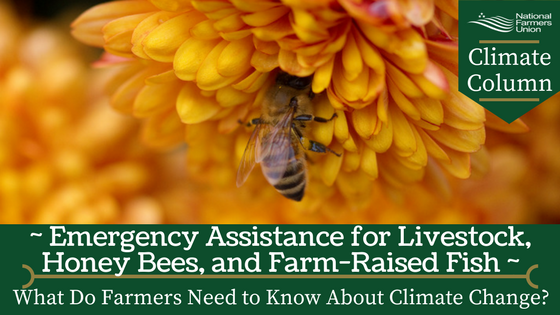In 2017, flooding, wildfires, hurricanes, and other natural disasters accounted for approximately $5 billion worth of economic losses in the US agriculture sector. The toll is expected to increase as climate change intensifies the strength and duration of these weather events. As a direct result, the amount of physical damage to farm and ranch operations will also continue to rise.
The U.S. Department of Agriculture (USDA) Farm Service Agency (FSA) offers programs to alleviate some of the economic setbacks caused by these events. The Livestock Forage Program (LFP) provides financial assistance to producers experiencing difficulties feeding livestock on account of forage losses caused by fires or droughts, while the Livestock Indemnity Program (LIP) offers compensation for livestock mortality. These programs are useful, but unfortunately cover only a narrow list of livestock and disasters. That’s where the Emergency Assistance for Livestock, Honey Bees, and Farm-Raised Fish Program (ELAP) comes in.
ELAP was created to provide coverage to producers not eligible to receive payments through LFP and LIP. Losses covered by ELAP include a variety of inclement weather-induced livestock, honey bee, and farm-raised fish mortality; expenses associated with the inability to supply water to livestock during drought events; reduced access to feed not due to droughts and fires; and costs incurred from treating livestock diseases. Honey bees and fish that were monitored in a controlled environment and contributed to commercial profits throughout their lifetime are examples of types of animal deaths that may qualify for financial compensation. Click here to learn more about eligibility criteria for ELAP.
ELAP payments reimburse producers for 60-75 percent of value lost, depending on the type of animal, circumstance and cause of death, and extent of reduced access to feed. The 2014 Farm Bill capped funding for ELAP at $20 million per fiscal year. Currently, honey bee farmers have been the primary recipient of ELAP payments, as Colony Collapse Disorder is on the rise and it is the only disaster program that administers financial support for bee farming.
Like other disaster assistance programs, ELAP’s application process tends to be lengthy, and 100 percent financial compensation is not realistic. Producers should be conscious of their management practices to proactively protect livestock and increase chances of survival in the case of natural disaster. Maintaining healthy animals by minimizing disease transmission, providing nutritious meals, and establishing adequate shelters will improve the resilience of your herd, hive, or school.
Click here to review the ELAP payment application online (Form CCC 934). Click here to locate a Farm Service Agency (FSA) office near you and request Form CCC 934. Documents that provide evidence to claims need to accompany the application during submission.
Have you utilized ELAP payments because you were ineligible to receive assistance through LFP or LIP? How was your experience? Share your thoughts in the comments below.
Like what you’ve read? Check out our Climate Leaders home page, join the conversation in the NFU Climate Leaders Facebook Group, and keep up-to-date with NFU climate action by signing up for the mailing list.
